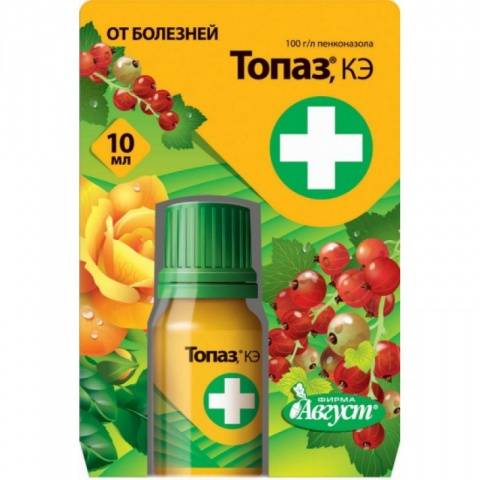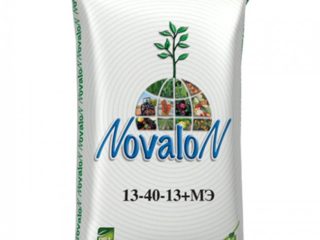Content
Fungal diseases affect fruit trees, berry gardens, vegetables and flowers. One way to protect a plant from fungus is to use the fungicide Topaz. The product has a long period of action and high efficiency. It is used both for preventive purposes and to combat existing lesions.
Features of the drug
Fungicide Topaz is a chemical that belongs to the class of triazoles. Its action is based on penconazole, which inhibits the functioning of fungal spores. As a result, the spread of fungal spores is stopped.
After use, the substance does not form a film on the surface of leaves and shoots. The active substance penetrates the walls of plant cells.
You can purchase the product in 2 ml ampoules or 1 liter plastic containers. The shelf life of the drug is 4 years. An analogue is the drug Almaz.
Fungicide Topaz is used to combat the following diseases:
- powdery mildew;
- various types of rust on leaves;
- oidium;
- gray rot;
- purple spotting.
Topaz is compatible with many chemicals and prolongs the positive effect of their use. Alternating fungicides can increase the effectiveness of treatments.
Most often, Topaz is used in conjunction with the following drugs:
- Horus - to get rid of Alternaria and coccomycosis;
- Kuproxat – for the treatment of late blight and cercosporiasis;
- Kinmiks - for pest control;
- Topsin-M - in the form of therapeutic measures when signs of anthracnose, scab, and fruit rot appear.
Advantages
Choosing the fungicide Topaz has the following advantages:
- wide scope of application;
- long exposure period, allowing to reduce the number of treatments;
- good performance (fungal development stops 3 hours after applying the solution);
- high efficiency at low temperatures and exposure to moisture;
- low consumption of the drug;
- suitable for most garden and flower crops;
- used at any period of the growing season: from bud opening to fruit ripening;
- low toxicity;
- compatibility with other remedies against diseases and pests.
Flaws
The disadvantages of Topaz fungicide include:
- the need to comply with safety precautions;
- the active substance disintegrates in the soil within 2-3 weeks;
- the period of use on the site is no more than 3 years, after which a break is required;
- high toxicity for water inhabitants.
Instructions for use
To obtain a working solution, first dilute the suspension in 1 liter of water. The resulting mixture is stirred, after which the required amount of water is added. The rate of Topaz fungicide is selected according to the instructions depending on the type of plants to be treated.
Vegetables
Topaz helps protect cucumbers planted in a greenhouse or open ground from the spread of powdery mildew. To obtain a solution, take 2 ml of fungicide and 10 liters of water.
Consumption for greenhouse plants is 0.2 l per 1 sq. m. For vegetables growing in open areas, 0.1 liter is enough. Spraying is necessary when the first alarming symptoms occur.
If signs of the disease persist, the plants are treated with Topaz fungicide again after a few weeks. For vegetable crops, no more than 4 treatments are allowed per season.
Fruit trees
Apple, pear, peach and cherry trees may show symptoms of fruit rot. The disease affects the fruits, which become mummified and remain hanging on the branches. The disease spreads very quickly throughout the garden and leads to crop loss.
Another dangerous disease is powdery mildew, which has the appearance of a whitish coating that affects shoots and foliage. Gradually, the above-ground parts of the trees become deformed and dry out.
To protect trees from diseases, prepare a solution containing, according to the instructions for use, 1 ml of Topaz fungicide and 5 liters of water. Trees are treated by spraying. For seedlings, use 2 liters of the resulting solution; adult trees require 5 liters.
During the season, up to 4 treatments with Topaz are allowed. For preventive purposes, the period of budding or after the end of flowering is chosen for spraying.
Berry bushes
Gooseberries, currants, raspberries and other berry bushes suffer from powdery mildew. A white coating appears on shoots, foliage and berries. The spread of the disease begins from the lower branches. To protect plantings from fungus, prepare a solution consisting of 3 ml of the drug per 15 liters of water.
Treatment is carried out when the first alarming symptoms appear. Preventive spraying is carried out during the formation of the first inflorescences and after flowering. During the season it is allowed to spray the bushes 4 times. Fungicide Topaz is not used 20 days before harvesting or later.
Grape
One of the most dangerous diseases of grapes is oidium. Yellowish swollen spots covered with a white coating appear on the leaves. Gradually, the leaves become deformed and the inflorescences fall off.
To protect grapes from oidium, prepare a working solution of Topaz fungicide. 2 ml of concentrate is dissolved in 10 liters of water. Plantings are treated by spraying on the leaf. Consumption per 10 sq. m is 1.5 l.
The first treatment with Topaz is necessary after bud break, and a second treatment after flowering. During the season, the number of treatments should not exceed 4.
Strawberries
In cold and rainy weather, signs of powdery mildew appear on strawberry leaves in the form of a white coating. As a result, the leaves curl and dry out, the berries crack and turn brown.
Another dangerous disease of strawberries is rust. Brown spots appear on the leaves, which gradually grow. As a result, strawberry yields decrease.
To treat strawberries against fungal infections, prepare a solution consisting of 3 ml of a suspension of the drug Topaz in a large bucket of water. Plantings are sprayed leaf by leaf.
The first treatment is carried out before flowering begins. Additionally, strawberries are processed after harvesting. During the season, 2 applications of Topaz fungicide are sufficient.
Roses
In cold and humid climates, roses suffer from powdery mildew and rust.Signs of lesions are diagnosed on the leaves of plants, as a result of which development slows down and the decorative qualities of the flower are lost.
To treat roses, prepare a solution of 4 ml of Topaz concentrate and 10 liters of water. Spraying is done per leaf. During the season, no more than 3 treatments are carried out. Wait 20 days between procedures.
Flower garden
Rust and powdery mildew affect flowers growing outdoors and at home. Signs of diseases occur in carnations, violets, mallow, iris, clematis, peony, and chrysanthemum.
To combat diseases, prepare a solution of 3 ml of Topaz and 10 liters of water. Leaves and shoots are sprayed in cloudy weather. If necessary, the treatment is repeated, but no more than 3 times during the season.
Precautionary measures
Fungicide Topaz is a substance of hazard class 3, toxic to fish. The drug is not dangerous for birds and insects. When working with the substance, observe safety precautions.
While applying the Topaz fungicide, smoking, eating or drinking is prohibited. Work is carried out on a dry, cloudy day or in the evening. Allowable wind speed is up to 5 m/s.
When working with the solution, it is important to protect the skin and respiratory system. It is better to use a respirator and protective suit. People who do not have protective equipment and animals should be kept at a distance of more than 150 m from the treatment site.
When administering Topaz fungicide, you must drink 2 glasses of water and 3 tablets of activated carbon and induce vomiting. You definitely need to see a doctor.
Reviews from gardeners
Conclusion
The drug Topaz effectively copes with fungal infections on vegetable and garden crops. Plants are treated by spraying. Fungicide is added according to the rate established for each crop. When interacting with the drug Topaz, observe safety precautions.













